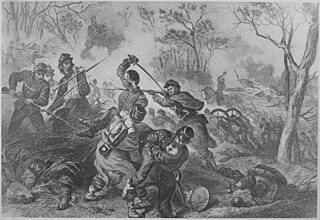
The siege of Port Hudson was the final engagement in the Union campaign to recapture the Mississippi River in the American Civil War. While Union General Ulysses Grant was besieging Vicksburg upriver, General Nathaniel Banks was ordered to capture the lower Mississippi Confederate stronghold of Port Hudson, Louisiana, to go to Grant's aid. When his assault failed, Banks settled into a 48-day siege, the longest in US military history up to that point. A second attack also failed, and it was only after the fall of Vicksburg that the Confederate commander, General Franklin Gardner, surrendered the port. The Union gained control of the river and navigation from the Gulf of Mexico through the Deep South and to the river's upper reaches.
The Battle of Plains Store was fought on May 21, 1863, in East Baton Rouge Parish, Louisiana, during the campaign to capture Port Hudson in the American Civil War. Union troops advancing from Baton Rouge, Louisiana, clashed with 600 Confederates at a road junction. The initial Confederate force withdrew, but 400 more Confederates arrived from Port Hudson. Some of the Confederate reinforcement overran Union artillery and routed a Union regiment, but were unable to capture the guns. Union reinforcements advanced to the front, attacked part of the Confederate force and drove them from the field. The Confederates withdrew to Port Hudson, which was almost entirely surrounded by Union troops the next day. Port Hudson was under siege until the defenders surrendered on July 9.

George Leonard Andrews was an American professor, civil engineer, and soldier. He was a brigadier general in the Union Army during the American Civil War and was awarded the honorary grade of brevet major general.

Henry Livermore Abbott was a Major in the Union Army during the American Civil War. Abbott was posthumously awarded the grade of brevet brigadier general, United States Volunteers, to rank from August 1, 1864, and the grades of brevet lieutenant colonel, brevet colonel and brevet brigadier general, United States Army, all to rank from March 13, 1865 for gallant and meritorious services at the Battle of the Wilderness, where he was killed in action. Abbott was engaged at the center of several key Civil War battles and was widely known and admired for his leadership, courage and composure under fire.

William Francis Bartlett was a general in the Union Army during the American Civil War and, later, an executive in the iron industry.
The 53rd Massachusetts Volunteer Infantry was an infantry regiment recruited in Massachusetts for service in the American Civil War. The volunteers, mostly farmers, predominantly hailed from north-central Massachusetts.
The 41st Regiment Massachusetts Volunteer Infantry was a three-year infantry regiment that served in the Union Army during the American Civil War. It was recruited as part of Governors Banks' and Andrew's recruitment drives to supply the union with a military force to hold and expand Union control of the lower Mississippi. In the late winter/early spring of 1863, it was converted to mounted infantry and later to cavalry. On its conversion in June 1863 at Port Hudson, it was disestablished and re-established as the 3rd Massachusetts Volunteer Cavalry.

The 29th Regiment Massachusetts Volunteer Infantry was an infantry regiment in the Union army of the United States during the American Civil War. The regiment was organized in December 1861 when three new companies were attached to a battalion of seven Massachusetts companies that had been in active service since May 1861. These seven companies had been recruited to fill out the 3rd Massachusetts and 4th Massachusetts regiments and had signed on for three years of service. When the 3rd and 4th Massachusetts were mustered out in July 1861, the seven companies that had signed on for three years were grouped together to form a battalion known as the Massachusetts Battalion. Finally, in December 1861, three more companies were added to their roster to form a full regiment and the unit was designated the 29th Massachusetts.
The 3rd Massachusetts Volunteer Cavalry Regiment was a cavalry regiment that served in the Union Army during the American Civil War. It was organized by consolidating the 41st Massachusetts Mounted Infantry and the 2nd Battalion Massachusetts Cavalry on June 17, 1863. The regiment served with the XIX Corps, Army of the Gulf during the Red River Campaign in 1864. Its heaviest combat during this campaign took place during the Battle of Sabine Crossroads.

The 42nd Regiment Massachusetts Volunteer Infantry was a regiment of infantry that served two tours in the Union Army during the American Civil War. The unit was first formed in September 1862 in response to President Abraham Lincoln's call for 300,000 men to serve for nine months.

The 4th Regiment Massachusetts Volunteer Militia, sometimes known as the 4th Massachusetts Infantry, was a peacetime regiment of infantry that was activated for federal service in the Union Army for two separate tours during the American Civil War. Most of the companies were from Norfolk County, Massachusetts. The regiment had its headquarters in Quincy, Massachusetts.

The 48th Regiment Massachusetts Volunteer Infantry was a regiment of infantry that served in the Union Army during the American Civil War. It was one of the 18 Massachusetts regiments formed in response to President Abraham Lincoln's August 1862 call for 300,000 men to serve for nine months. It consisted of a combination of Essex County companies and Irish-American companies which caused some delay and friction during the unit's formation. The regiment was assigned to the Department of the Gulf and saw heavy combat during the Siege of Port Hudson.

The 50th Regiment Massachusetts Volunteer Infantry was a regiment of infantry that served in the Union Army during the American Civil War. It was one of the 18 Massachusetts regiments formed in response to President Abraham Lincoln's August 1862 call for 300,000 men to serve for nine months. The regiment was recruited in Essex County and rendezvoused for mustering in at Camp Edwin M. Stanton in Boxford, Massachusetts. The 50th Massachusetts was assigned to the Department of the Gulf under Major General Nathaniel P. Banks and shipped for Louisiana. The regiment saw combat during the Siege of Port Hudson.

The 52nd Regiment Massachusetts Volunteer Infantry was a regiment of infantry that served in the Union Army during the American Civil War. It was one of the 18 Massachusetts regiments formed in response to President Abraham Lincoln's August 1862 call for 300,000 men to serve for nine months. The regiment was recruited in Franklin and Hampshire Counties and rendezvoused for mustering in at Camp Miller in Greenfield, Massachusetts. The 52nd Massachusetts was assigned to the Department of the Gulf under Major General Nathaniel P. Banks and shipped for Louisiana. The regiment participated in the Bayou Teche campaign in western Louisiana during April and May 1863 and then saw combat during the Siege of Port Hudson.

The 57th Regiment Massachusetts Volunteer Infantry was a regiment of infantry that served in the Union Army during the American Civil War. It was one of the four "Veteran Regiments" raised in Massachusetts during the winter of 1863–64. Recruits of these regiments were required to have served at least nine months in a prior unit. Colonel William F. Bartlett, at age 24 already a veteran of three regiments, organized the recruiting and formation of the 57th Massachusetts and served as its first commanding officer.

The 4th Massachusetts Battery was an artillery battery that served in the Union Army during the American Civil War. The unit was sometimes known as "Manning's Battery" after its commanding officer, Capt. Charles H. Manning. It was one of the Massachusetts regiments organized in response to President Abraham Lincoln's call on May 2, 1861 for volunteer troops to serve a term of three-years. The core of the unit was a peace-time militia company known as the Salem Light Artillery. The battery trained at Camp Chase in Lowell, Massachusetts. It was assigned to the Department of the Gulf under Major General Benjamin F. Butler and departed Boston by steamship on November 20.

The 6th Massachusetts Battery was an artillery battery that served in the Union Army during the American Civil War. The unit was one of the Massachusetts regiments organized in response to President Abraham Lincoln's call on May 2, 1861 for volunteer troops to serve a term of three-years. The battery trained at Camp Chase in Lowell, Massachusetts. It was assigned to the Department of the Gulf under Major General Benjamin F. Butler and departed Boston by steamship on February 8, 1862. At that time, the unit comprised 145 men armed with two rifled and four smoothbore six-pounder field guns.

The 12th Massachusetts Battery was an artillery battery that served in the Union Army during the American Civil War. The unit was organized at Camp Meigs near Boston during the fall of 1862. Its members were mustered in at various times over the fall and the officers mustered into federal service on December 8, 1862. It was assigned to the Department of the Gulf under Major General Nathaniel P. Banks and departed Massachusetts by steamship on January 3, 1863.

The 4th Louisiana Infantry Regiment was a unit of volunteers recruited in Louisiana that fought in the Confederate States Army during the American Civil War. Formed in May 1861, the regiment served in the Western Theater of the American Civil War. The unit fought at Shiloh and Baton Rouge in 1862 and at Jackson in 1863. A detachment served during the Siege of Port Hudson and was captured. In 1864, the regiment fought in the Atlanta campaign where it lost heavily at Jonesborough. At Nashville in December 1864 most of the men were captured. The survivors were consolidated with several other units and fought at Spanish Fort in April 1865. The remnant surrendered in May 1865.

The 4th United States Colored Cavalry Regiment was an African American cavalry regiment that served in the Union Army during the American Civil War. The regiment mustered in as the 1st Cavalry (Corps d'Afrique) at New Orleans on September 12, 1863 and was stationed for the entirety of its existence at various bases throughout Louisiana, mustering out at New Orleans on March 20, 1866.










